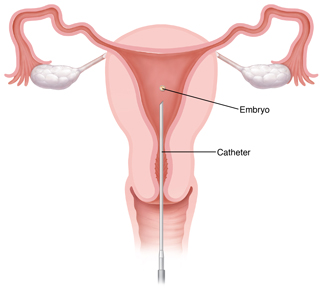In Vitro Fertilization (IVF)
If you have fertility problems, your healthcare provider may advise you to try in vitro fertilization (IVF). With IVF, eggs and sperm are combined outside your body. It's done in a lab. A fertilized egg (embryo) is then placed in your uterus to grow. In most cases, IVF is done with hormone medicines. These help to increase the chances of success. Talk with your healthcare provider. They can tell you more about the details, success rates, and costs of IVF.
How IVF works
There are 4 main steps during IVF:
-
Hormone medicine is used to stimulate the ovaries. This helps them to produce 2 or more mature eggs.
-
The mature eggs are taken from the ovaries. You will be given medicine (sedation). This is so you won't feel pain. Your healthcare provider guides a thin needle into your vagina. This is done with the help of ultrasound.
-
The eggs are combined with sperm in a lab. If needed, 1 sperm can be injected directly into an egg. This is called intracytoplasmic sperm injection (ICSI).
-
A few days later, 1 or more embryos are placed into your uterus. For many people, the chance of pregnancy with 1 embryo is excellent. This reduces the risk of a multiple pregnancy. A multiple pregnancy means 2 or more babies. The American Society for Reproductive Medicine has advice for how many embryos to transfer. This is based on your age and the quality of the embryos.

Freezing embryos
Many embryos are created during an IVF cycle. But not all are placed in the uterus. The rest may be frozen for later use. This means you don't have to do another cycle of egg retrieval. It is also less costly.
© 2000-2024 The StayWell Company, LLC. All rights reserved. This information is not intended as a substitute for professional medical care. Always follow your healthcare professional's instructions.